We aim to channel, understand, and revitalise culture
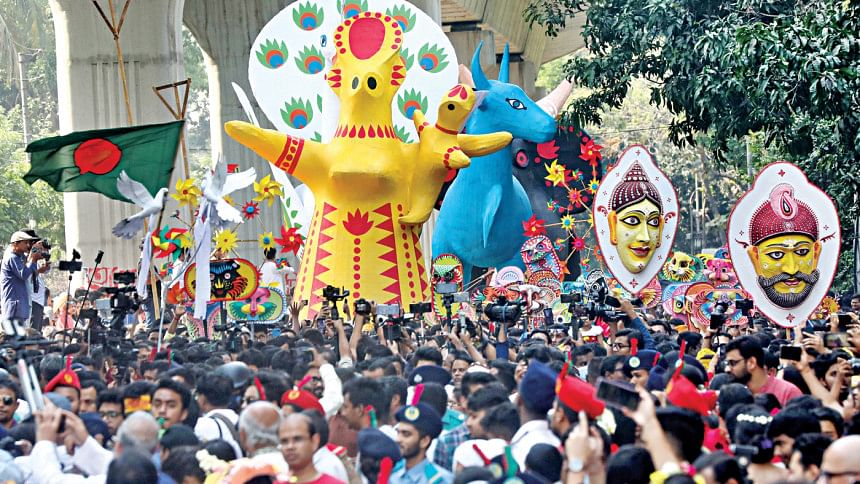
The Daily Star (TDS): Considering the significance of the July Movement, how do you perceive the overall concept of culture, particularly its role as a force for social transformation and identity formation?
Syed Jamil Ahmed (SJA): First, it is crucial to define 'culture', which can be understood in two senses—anthropological and functional. The anthropological aspect refers to the people's way of life—their values, norms, knowledge, and beliefs, which cannot be changed overnight. The functional aspect refers to an organised sector of human intellectual and artistic creativity, including arts, literature, and cultural institutions.
The July movement has highlighted an overlooked aspect of Bangladeshi culture. While secularists separate religion from public life, cultural nationalists (myself included) must acknowledge that Islam, an integral part of Bangladeshi culture, influences daily life. The movement has also demonstrated the political awareness of Gen Z, showing they are deeply engaged rather than indifferent.
Rather than driving social transformation, the uprising is about identity formation, bringing unresolved questions to the forefront—such as Islam's role in daily life and artistic expression. For instance, should sculpture continue figurative representation, or should it be abandoned? We live in a time when these questions are being actively discussed making this moment both exciting and significant. Unfortunately, incidents such as attacks on Baul communities and vandalism of mazars (shrines) have occurred, which are unwanted expressions of the movement.
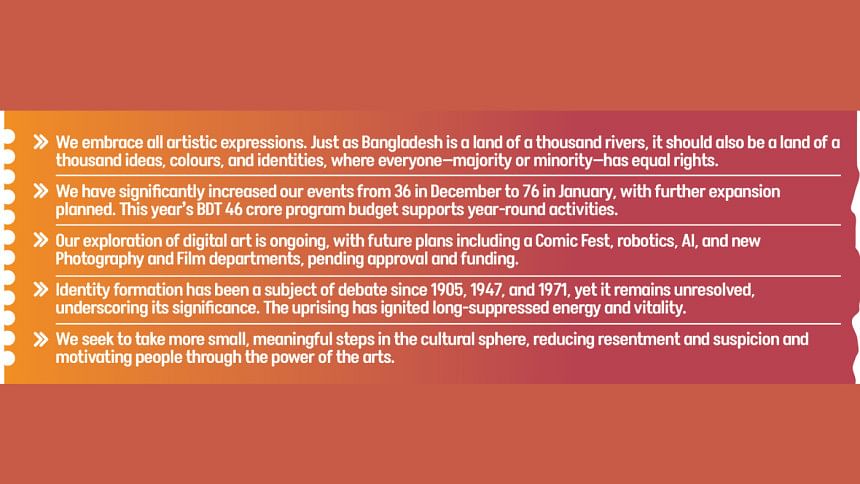
Despite external pressures, including media narratives and political threats from India, Bangladesh remains stable. Cultural nationalists must now accept that religion influences all aspects of life, including the arts. This does not signal Talibanisation, rather it simply means that religious expression is a personal choice—someone who wishes to wear a hijab should have the freedom to do so, just as someone who does not want to should have the same right.
Identity formation has been debated since 1905, 1947, and 1971, yet remains unresolved, signaling its importance. The uprising has unleashed long-suppressed energy and vibrancy. With an interim government in place, major political decisions may be delayed, but these crucial questions must be addressed for the future.
TDS: As a national center for art and culture, what role do you believe Shilpakala Academy can play in this regard?
SJA: I believe the arts plant new ideas—like seeds that grow into trees, guiding the way forward. Our role is not to provide answers but to create an environment where questions can be raised—through discussions and the arts. We have a dedicated forum called Bahas, where people from diverse ideologies come together to discuss, debate, and raise questions.
We embrace all artistic expressions. Just as Bangladesh is a land of a thousand rivers, it should also be a land of a thousand ideas, colours, and identities, where everyone—majority or minority—has equal rights.
Through music, theater, and performance, we present alternative perspectives, inspiring thought and introspection. Shilpakala Academy celebrates life and diversity and envisions making Bangladesh a country of festivity including festivals with ethnic communities in the north, south, and beyond.
To make the arts people-oriented, we take performances beyond auditoriums to open spaces. I attended a performance in Tangail where rickshaw pullers, after a long day's work, joined the audience. Among them sat the Deputy Commissioner and other community members—a gathering of 400 to 500 people, united by art. This is what we strive for. Our goal is to make culture as vital as air or food—a central part of everyday life.
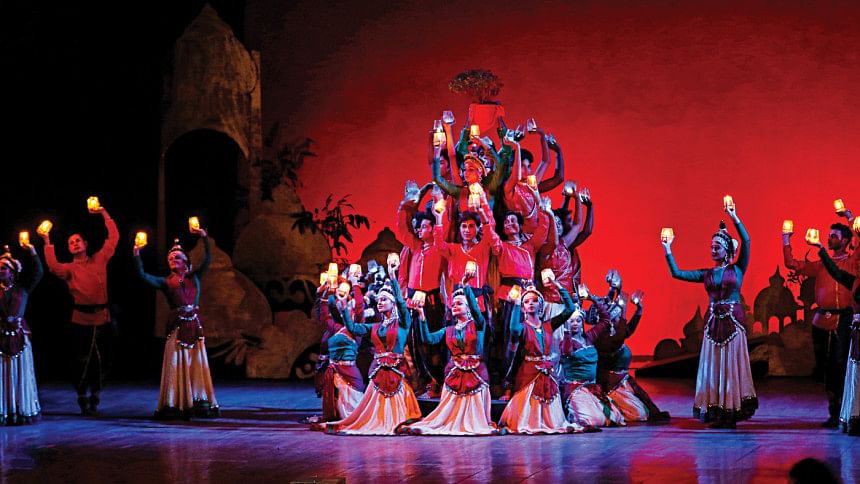
When I joined, this institution was plagued by financial and administrative indiscipline. My priority was stakeholder engagement, identifying two areas requiring urgent attention: administrative discipline and financial transparency.
Reforms have been implemented—event expenses are now uploaded online, and strict compliance ensures no files are processed without meeting regulations. The administration was in disarray, but we have restored order by enforcing procedures and guidelines to create a more systematic structure. In a major reform, we transferred 34 cultural officers—some after 11 years, despite the three-year rotation policy. Our chain of command is now more transparent.
We are fostering a vibrant cultural atmosphere, expanding outreach to remote villages and districts. Our approach to culture is not mere preservation—because culture is dynamic by nature, constantly evolving like a river. Instead, we aim to channel, understand, and invigorate it. Where revitalisation is needed, we provide support, and where barriers hinder growth, we work to remove them.
We have significantly increased our events from 36 in December to 76 in January, with further expansion planned. This year's BDT 46 crore program budget supports year-round activities.
Talent development is key—district branches train children in dance, music, theater, and painting. By January, I had visited 16 districts, witnessing emerging talent. Institutions like Kochi Kachar Mela once played this role, but Shilpakala Academy is now filling that gap, with some districts training up to 600 students. Talent-hunting competitions, halted last year, will resume soon.
Training remains central—our new workshop program launched on January 20 covers all 64 districts, ending in a final festival (Feb 21-28). We aim to modernise Jatra plays and introduce band music, rap, monthly Baul evenings, and digital arts. We recently held a poster exhibition on the July uprising and integrated digital arts—VR and AR—into our gallery, transforming 20 of Debashish Chakrabarty's posters.
Our exploration of digital art is ongoing, with future plans including a Comic Fest, robotics, AI, and new Photography and Film departments, pending approval and funding.
TDS: What challenges have you faced so far while implementing these reforms in fulfilling Shilpakala Academy's mission?
SJA: Challenges have been immense—both internal and external. Internally, I faced resentment, much of it justified as merit was often overlooked in favour of political ties or proximity to the Director General. We have worked to change this, but after 15 years of oppression, mistrust was inevitable.
I have no personal agenda—only a commitment to ensuring that the sacrifice of 1,500 people in the July uprising is not in vain, which is why I accepted this responsibility, though I initially declined. Leading Shilpakala Academy has since become a 24-hour commitment.
Despite my clear intentions, suspicion persists—fueled by deliberate misinterpretations, as seen in the Desh Natok incident. Still, I remain focused on engaging with the people.
Surprisingly, bureaucracy has not been a hurdle. I made it clear upon joining that there should be no unnecessary intervention since Shilpakala Academy is an autonomous body. While the ministry has the right to advise us and question any unconstitutional or illegal steps, there should be no undue interference—which they have respected. Now, things are stabilising—internally, externally, and with the ministry. Hopefully, we can now entirely focus on our work.
TDS: How can Shilpakala Academy collaborate with other cultural institutions, both nationally and internationally, to enhance its impact on cultural preservation and exchange?
SJA: We collaborate with Alliance Française, staging a performance in Khulna and planning another play. A major initiative is creating a professional repertory theater company at Shilpakala Academy, including a French play in translation, marking a significant cultural exchange.
Internationally, we hosted a Chinese traditional opera on January 21 and are negotiating with the Chinese government to establish a dormitory and workshop facility at Shilpakala Academy. If approved, it will accommodate district artists, international guests, and provide a workshop space for theater practitioners. We are also exploring partnerships with UNESCO and the British Council.
In collaboration with the Rainbow Film Festival and Dhaka Film Festival, we plan to showcase Middle Eastern films across Bangladesh, highlighting Muslim women's participation in the arts to promote intercultural dialogue. Additionally, we aim to create a South Asian cultural event fostering regional collaboration and ensuring equal representation from all South Asian countries.
Collaboration is essential to our mission. We plan to bring VR and AR exhibitions to schools in regions like Rangpur, offering interactive experiences to inspire students. We are also developing a new framework for collaboration with national art institutions to produce performances and facilitate nationwide showcases.
For too long, ethnic communities have been marginalised. We aim to help them stage their own plays to voice their grievances. A recent Marma festival in Bandarban featured their first performance in 12 years, in their own language, among their own people. Initially met with tension, the event ended in joy, with a Brigadier General dining in a Marma household—an unprecedented act of trust—attended by the Deputy Commissioner and one of our advisors.
We seek to take more small, meaningful steps in the cultural sphere, reducing resentment and suspicion and motivating people through the power of the arts.
The interview was taken by Saudia Afrin.
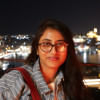
 For all latest news, follow The Daily Star's Google News channel.
For all latest news, follow The Daily Star's Google News channel. 


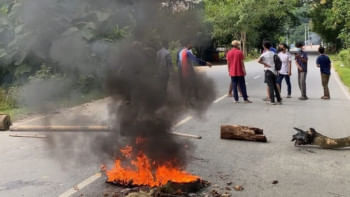
Comments